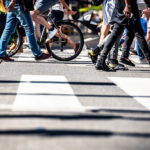No one knew Jon Meis would be a hero that day, not even Jon Meis. The 22-year-old engineering student, who describes himself as “quiet and private,” was working as a building monitor at Seattle Pacific University on June 5, 2014, when a gunman began firing at random.
Meis tackled and disarmed the shooter, which then inspired several others to hold down the attacker until police arrived. The rampage left one person dead and three wounded, but the toll likely would have been much higher.
The story received some media attention at the time, but not much. Perhaps it was overshadowed by the upcoming 70th anniversary of D-Day, when the nation’s focus was on heroes in uniform. Perhaps the situation was defused too quickly or the number of victims too low to catch the media’s sensationalized eye.
Yet heroes like Meis undeniably walk among us every day, unnoticed and unheralded by special holidays, medals or sometimes even a nod from our fellow humans.
In Minnesota, Ken Hawj jumped 30 feet from a cliff into the St. Croix River to save an 11-year-old boy who was being swept away by the strong current. He did not know the boy; he simply acted. Why?
In Pennsylvania, Jeremy Berish ran from his house to pull an unconscious woman from a car engulfed in flames. He could have called 911. He could have knocked on a neighbor’s door for help, delaying the woman’s rescue past the point of survival. But he didn’t. What was going on inside his mind?
All of these incidents happened within 11 days of each other. Eleven random days in the U.S. in spring. There were other stories like theirs within those 11 days, just as there have been many before and after.
And they all have one thing in common: For a life to be saved, a split-second decision had to be made. For whatever reason, these particular people chose to put their own lives at risk for people they did not know.
When questioned afterward, a recurring theme of humility exists between the three men:
“I know that I am being hailed as a hero, and… I find this hard to accept,” Meis said.
“I thought of nothing. I just said to myself, I don’t have to be afraid,” Hawj recalled.
“That term [hero] is being used, but I don’t really see it that way,” said Berish.
Many heroes do what they think is right, regardless of who is watching. They just do what they think anyone would do, never realizing that their thought processes may be unique. They aren’t thinking about what their actions mean; they’re just thinking about their actions. This may be why they are confused and humble when people call them heroes.
Although bystanders may come to help, it’s the first responder who is always the bravest, the most decisive and the most observant. Unfortunately, the first person may not always be the most successful.
For some heroes, their knee-jerk reactions have cost them their lives. Sandy Hook Elementary School principal Dawn Hochsprung died while lunging at mass shooter Adam Lanza, who would eventually take the lives of 20 children and six adults in Newtown, Connecticut, in 2012. The choice to act immediately is one that these types of heroes make, but in many cases it can be a tragic one.
Hugo Alfredo Tale-Yax was another ordinary hero. He was not a leader in the traditional sense of the word. Homeless in New York City, it was Tale-Yax alone who saved a woman from a knife-wielding attacker before he was stabbed himself, then left to die on a sidewalk while two dozen people indifferently walked by in April 2010.
These heroes must not have felt they could live with themselves had they chosen any other path. They would have been haunted for the rest of their lives with a thousand what-ifs. So they acted.
Wayne State University psychiatry professor Deane Aikins researched stress levels in survival situations in the military. He found that those who performed heroic acts cultivated social bonds both before and after the crisis.
Certainly these bonds occur in soldiers, police officers and firefighters, whose professions inherently involve life-or-death scenarios. The connections forged under duress have proved themselves countless times on the job or during war, and friendships made in times of tragedy can last a lifetime. However, these groups have been trained to deal with physical danger and high-risk situations, and camaraderie is an inherent part of the job.
In releasing the results of his study in 2009, Aikins said that while no person is born without fear, his research found that a small percentage of people are biologically better equipped to deal with it.
“I think some people are born with it,” Aikins said, citing the example of Chesley “Sully” Sullenberger, the US Airways pilot who successfully landed his plane on New York’s Hudson River, saving the lives of all 155 people aboard. Aikins explained, “Their stress hormones are lower and the peptides that down-regulate that stress are higher,” so the hormonal system “really hits overdrive.” In other words, some of us naturally just don’t stress out as much as others. Born heroes have lower levels of stress hormones, while their bodies release another hormone that calms them down.
“Certain people are cooler under pressure, and they perform very, very well during these periods of time,” Aikins said.
We don’t know whether Aikins’ biological findings also apply to untrained heroes, the lone champions who are willing to die for the benefit of a stranger.
But these people do seem to be cut from a different cloth. It appears that their value systems are so deeply entrenched that when faced with a challenging situation, they don’t think—they just do. They don’t need time to think because they’ve already chosen the way they want to live.
“The key to heroism is a concern for other people in need—a concern to defend a moral cause, knowing there is a personal risk, done without expectation of reward,” says Stanford University professor emeritus of psychology Philip Zimbardo, whose past research has studied the nature of heroism.
Jon Meis was this type of hero, and in acting alone, he inspired others to act. But if Meis had not stepped forward, it’s highly possible that no one else would have. The “bystander effect” is a groupthink paralysis by which many people, assuming that others in the group will help, do nothing. The larger the group, the less inclined people are to act. Basically, what occurs is a shifting of personal responsibility: I don’t have to help because I’m certain someone else will.
In a notorious case from 2009, a 15-year-old girl was repeatedly beaten and gang-raped outside her high school’s homecoming dance in Richmond, California. About two dozen people watched, but no one called police during the nearly 2½-hour attack… until one woman finally did. She did not witness the attack; she had only heard about it.
A boy who was present during the attack was later reported as saying, “I feel like I could have done something, but I don’t feel like I have any responsibility for anything that happened.”
The bystander effect sounds harsh, but responsibility can be diffused among a crowd, causing a crisis to become impersonal and dehumanizing. If you’re in trouble, researchers say that one effective way to overcome the bystander effect is to “single out an individual from the crowd, make eye contact and directly ask for assistance.” Do everything you can to humanize the situation.
The same advice can also be applied to hostage situations. A popular thread on the question-and-answer website Quora asks, “What should you do if someone puts a gun to your head?” Former police officer Justin Freeman’s top advice, other than staying calm, is merely to make eye contact with the assailant. “It sounds simplistic, but looking into their eyes forces them to acknowledge, if only to themselves, your humanity in this situation,” Freeman writes.
Zimbardo says another conclusion of his research is that “few people do evil and fewer act heroically.”
“Between these extremes in the bell curve of humanity are the masses—the general population who do nothing, whom I call the reluctant heroes—those who refuse the call to action and, by doing nothing, often implicitly support the perpetrators of evil,” Zimbardo says. “So on this bell curve of humanity, villains and heroes are the outliers. The reluctant heroes are the rest. What we need to discover is how to give a call of service to this general population.”
According to Zimbardo, heroism can be learned.
“Some people argue humans are born good or are born bad. I think that’s nonsense. We are all born with this tremendous capacity to be anything, and we get shaped by our circumstances…. So each of us may possess the capacity to do terrible things. But we also possess an inner hero. If stirred to action, that inner hero is capable of performing tremendous goodness for others,” Zimbardo says.
In 2010, Zimbardo founded his Heroic Imagination Project, an “organization that teaches people how to take effective action in challenging situations.” The program combines findings from scientific studies and hands-on psychological exercises. The intent of the project is to teach ordinary people to make wiser choices in negative situations and transform them into positive ones.
“Essentially, we’re trying to build the social habits of heroes, to focus on the other, shifting away from the me and toward the we,” Zimbardo says. And, in fact, isn’t that the same training that Aikins likely encountered in the military—the ideas of “service before self” and “never leave a buddy behind”? Some people may naturally be able to better handle stress, and some may have a built-in sense of camaraderie to bolster heroic actions, but according to Zimbardo, heroic principles themselves may be learned and practiced by anyone.
We can all choose to be people of action. We can all strive to find that little bit of hero inside of us.
Few human beings truly lack empathetic concern for others. Numerous scientific studies have shown that humans by their very nature are hardwired for connection.
When people turn their backs on others, they often cite fear as their primary motivation. In life-or-death situations, our “fight or flight” response is activated, overtaking our rational thought to help us focus solely on our survival. A surge of adrenaline and stress hormones fills our bodies, giving us extra energy, strength and awareness to help us face the threat. The response is biological, but the choice is psychological. Some people choose to face the threat head-on, even if they are at a physical disadvantage.
The woman who eventually called police in the homecoming dance attack told CNN that there was a saying in her town: “Snitches get stitches.”
But she called anyway.
Boxing manager Cus D’Amato, who has handled the careers of heavyweight champs, said, “The hero and the coward both feel exactly the same fear; only the hero confronts his fear and converts it into fire.”
And in that fire resides your inner hero.
This article was published in December 2014 and has been updated. Photo by trattieritratti/Shutterstock






